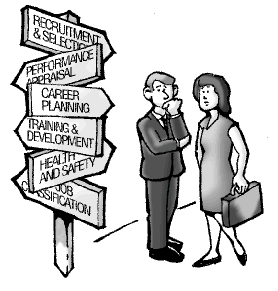Stockinged legs, high heels and a dash of lipstick. Smart suits, a neat tie and stylish boots. Millions of young men and women around the world aspire to become models, flight attendants and receptionists. Is it the glamour, the fame or just about looking good?
It is well known that doing things to improve one's appearance actually makes you feel better about yourself. Doctors and psychologists urge you to take care of your heath, your skin and your appearances. Cosmetics and accessories are often known to have positive physiological effects on people even if they don't show visible results. But what relation would all this have to HR?

In the 1930s efficiency experts in Britain and the United states came to a conclusion that women worked more efficiently when they had access to cosmetics. Besides leading to a huge demand and thus growth in the cosmetics industry this had other effects. Industrial plants were designed with primping rooms, make up tables and large mirrors along with other facilities for female workers. This led to a large number of women flocking to the war factories for work. Workers were urged to look good on the job, newsletters offered beauty tips to female workers and Lockheed even had beauty salons and cosmetic stations installed in its factories.
According to a 1942 New York Times report a regulation in the US back then ordered that girl workers in British munitions factories should wash and reapply cosmetics three times a day. Unbelievable but true- cosmetics for this purpose were even supplied by the government at a price of half a billion. Quite clearly, everyone believed that looking good not just led to a happier home and a more confident self but also growing revenues due to higher productivity.
More than half a century later, maybe the government has better things to spend on, yet employees looking and feeling good is still important to many corporates. We have restaurants who boast of their smart waiters, tech majors with gyms and petrol bunks attendants with neat uniforms. The demand for jobs that needs you to and lets you look good is higher than ever. And companies are relenting too. More jobs are created that include an interface with the customer and thus requires you to look good. Even jobs which did not earlier attract much attention now have smartly dressed staff- mechanics, sweepers, cleaners, parking lot attendants, etc.
What does all this mean to you? If you are a corporate, make sure a lot of the jobs in your organization have some contact with the outside world. Introduce styles of looking good, like ties and suits for formal presentations, formal wear when the client visits, smart casuals for one day of the week and so on. Feel free to look down on shabby and untidy clothing, informality is not an excuse to shoddiness. Bring down the essence of looking good to all your employees, even the clerks, the peons and all the support staff. Pay attention and invest in smart uniforms. Like Walt Disney, you could even go into the details like scrubbed nails and frequent baths, but that would be stretching it a little too far. Do make sure that your rest rooms are well lighted and have huge mirrors. For, trust me, that investment is all going to come back to you!
For someone who is working/ intends to work- Your job need not require you to look good. You could be a part of an assembly line or at a job where only your voice is head or your letters seen by people. Yet, if a little effort is going to go a long way at work, home and in attracting people to you, what are you waiting for?




